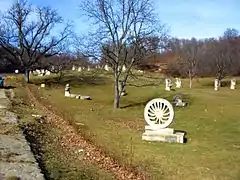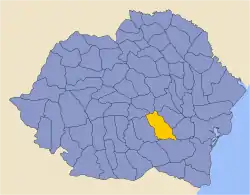Buzău County
Buzău County (Romanian pronunciation: [buˈzəw] (![]() listen)) is a county (județ) of Romania, in the historical region Muntenia, with the capital city at Buzău.
listen)) is a county (județ) of Romania, in the historical region Muntenia, with the capital city at Buzău.
Buzău County
Județul Buzău | |
|---|---|
County | |
 Coat of arms | |
 | |
| Coordinates: 45.27°N 26.77°E | |
| Country | |
| Development region1 | Sud-Est |
| Historic region | Muntenia |
| Capital city (Reședință de județ) | Buzău |
| Government | |
| • Type | County Board |
| • President of the County Board | Petre Emanoil Neagu (PSD) |
| • Prefect2 | Carmen Ichim |
| Area | |
| • Total | 6,103 km2 (2,356 sq mi) |
| Area rank | 17th in Romania |
| Population (2011) | |
| • Total | 432,054 |
| • Rank | 18th in Romania |
| • Density | 81/km2 (210/sq mi) |
| Time zone | UTC+2 (EET) |
| • Summer (DST) | UTC+3 (EEST) |
| Postal Code | 12wxyz3 |
| Area code(s) | +40 x384 |
| Car Plates | BZ5 |
| GDP | US$ 2.561 billion (2015) |
| GDP/capita | US$ 5,927 (2015) |
| Website | County Board County Prefecture |
| 1The developing regions of Romania have no administrative role. They were formed just to attract funds from the European Union 2 as of 2007, the Prefect is not a politician, but a public functionary. He (or she) is not allowed to be a member of a political party, and is banned to have any political activity in the first six months after the resignation (or exclusion) from the public functionary corps 3w, x, y, and z are digits that indicate the city, the street, part of the street, or even the building of the address 4x is a digit indicating the operator: 2 for the former national operator, Romtelecom, and 3 for the other ground telephone networks 5used on both the plates of the vehicles that operate only in the county limits (like utility vehicles, ATVs, etc.), and the ones used outside the county | |
Demographics
In 2011, it had a population of 432,054 and the population density was 70.7/km2.
| Year | County population[2] |
|---|---|
| 1948 | 430,225 |
| 1956 | |
| 1966 | |
| 1977 | |
| 1992 | |
| 2002 | |
| 2011 |
Geography
This county has a total area of 6,103 km2.
In the North Side there are the mountains from the southern end of the Eastern Carpathians group – the Vrancea Mountains and the Buzău Mountains with heights over 1,700 m. The heights decrease in the South and East passing through the subcarpathian hills to the Bărăgan Plain at about 80 m.
The main river crossing the county is the Buzău River which collects many small rivers from the mountains and flows to the East into the Siret River.
Economy
The predominant industries in the county are:
- Mechanical components; railway and automotive components
- Metallurgical parts
- Glass
- Food
- Textiles
- Wood
The hilly area is well-suited for wines and fruit orchards. Salt and oil are the main resources extracted in the county.
Tourism

The main tourist destinations are:
- The city of Buzău.
- The Vrancea Mountains and Buzău Mountains.
- The Berca Mud Volcanoes
- The amber museum in Colți
- The Ciolanu Monastery and the Măgura sculpture camp
- The Rătești Monastery
- The Amara Resort.
- The Sărata-Monteoru Resort.
Politics
The Buzău County Council, elected at the 2016 local government elections, is made up of 33 counselors, with the following party composition:[3]
| Party | Seats | Current County Council | ||||||||||||||||||||
|---|---|---|---|---|---|---|---|---|---|---|---|---|---|---|---|---|---|---|---|---|---|---|
| Social Democratic Party | 20 | |||||||||||||||||||||
| National Liberal Party | 9 | |||||||||||||||||||||
| Alliance of Liberals and Democrats | 2 | |||||||||||||||||||||
| Romanian Social Party | 2 | |||||||||||||||||||||
Administrative divisions
Buzău County has 2 municipalities, 3 towns and 82 communes.
- Municipalities
- Buzău – capital city; population: 108,384 (as of 2011)
- Râmnicu Sărat
- Towns
- Communes
- Amaru
- Bălăceanu
- Balta Albă
- Beceni
- Berca
- Bisoca
- Blăjani
- Boldu
- Bozioru
- Brădeanu
- Brăești
- Breaza
- Buda
- C.A. Rosetti
- Calvini
- Cănești
- Cătina
- Cernătești
- Chiliile
- Chiojdu
- Cilibia
- Cislău
- Cochirleanca
- Colți
- Costești
- Cozieni
- Florica
- Gălbinași
- Gherăseni
- Ghergheasa
- Glodeanu Sărat
- Glodeanu-Siliștea
- Grebănu
- Gura Teghii
- Largu
- Lopătari
- Luciu
- Măgura
- Mărăcineni
- Mărgăritești
- Mânzălești
- Merei
- Mihăilești
- Movila Banului
- Murgești
- Năeni
- Odăile
- Padina
- Pardoși
- Pănătău
- Pârscov
- Pietroasele
- Podgoria
- Poșta Câlnău
- Puiești
- Racovițeni
- Râmnicelu
- Robeasca
- Rușețu
- Săgeata
- Săhăteni
- Săpoca
- Sărulești
- Scorțoasa
- Scutelnici
- Siriu
- Smeeni
- Stâlpu
- Tisău
- Topliceni
- Țintești
- Ulmeni
- Unguriu
- Vadu Pașii
- Valea Râmnicului
- Valea Salciei
- Vâlcelele
- Vernești
- Vintilă Vodă
- Viperești
- Zărnești
- Ziduri
Historical county
Județul Buzău | |
|---|---|
County (Județ) | |
 The Buzău County prefecture building of the interwar period. | |
 Coat of arms | |
 | |
| Country | |
| Historic region | Dobrogea |
| Capital city (Reședință de județ) | Buzău |
| Area | |
| • Total | 4,936 km2 (1,906 sq mi) |
| Population (1930) | |
| • Total | 309,405 |
| • Density | 63/km2 (160/sq mi) |
| Time zone | UTC+2 (EET) |
| • Summer (DST) | UTC+3 (EEST) |
Historically, the county was located in the central-southern part of Greater Romania, in the northeastern part of the historical region of Muntenia. Its territory included the southern and western parts of today's Buzău County and several localities that are today in Prahova County, including the town of Mizil. It was bordered on the west by Prahova County, to the north by the counties of Brașov, Trei Scaune, and Putna, to the east by the counties of Râmnicu Sărat and Brăila, and to the south by Ialomița County.
Administration

The county has seen multiple subdivisions administratively.
At the end of the 19th century, the county was subdivided into six districts (plăṣi):[4]
- Plasa Sărata, with the town of Buzău and 16 communes
- Plasa Câmpului, with 14 communes
- Plasa Tohani, with the town of Mizil and 17 communes
- Plasa Buzău, with 17 communes
- Plasa Pârscov, with 16 communes
- Plasa Slănic, with 19 communes
In the interwar period, the territory of the county was initially divided into four districts:[5]
- Plasa Buzău, headquartered at Pătârlagele
- Plasa Câmpul, headquartered at Buzău
- Plasa Slănic, headquartered at Săpoca
- Plasa Tohani, headquartered at Mizil
Subsequently, the territory of the county was reorganized into seven districts, by abolishing Plasa Câmpul and establishing four new districts:
- Plasa Buzău, headquartered at Pătârlagele
- Plasa Câlnău, headquartered at Buzău
- Plasa Câmpeni, headquartered at Pogoanele
- Plasa Orașul, headquartered at Buzău
- Plasa Pârscov, headquartered at Pârscov
- Plasa Slănic, headquartered at Săpoca
- Plasa Tohani, headquartered at Mizil
Population
According to the 1930 census data, the county population was 309,405 inhabitants, ethnically divided as follows: 97.4% Romanians, 1.5% Romanies, 0.5% Jews, as well as other minorities. From the religious point of view, the population was 98.9% Eastern Orthodox, 0.5% Jewish, as well as other minorities.
Urban population
In 1930, the county's urban population was 42,127 inhabitants, comprising 91.2% Romanians, 3.7% Jews, 2.3% Romanies, 0.9% Hungarians, as well as other minorities. From the religious point of view, the urban population was composed of 93.3% Eastern Orthodox, 3.9% Jewish, 1.0% Roman Catholic, as well as other minorities.
References
| Wikimedia Commons has media related to Buzău County. |
- National Institute of Statistics, "Populația după etnie" Archived 16 August 2009 at the Wayback Machine
- National Institute of Statistics, "Populația la recensămintele din anii 1948, 1956, 1966, 1977, 1992 și 2002" Archived 22 September 2006 at the Wayback Machine
- "Mandate de CJ pe judete si competitori" (in Romanian). Biroul Electoral Central. 10 June 2016. Retrieved 16 June 2016.
- Lahovari, George Ioan (1899). Marele Dicționar Geografic al României. 2. Bucharest: Stab. grafic J. V. Socecu. p. 113.
- Portretul României Interbelice - Județul Buzău


